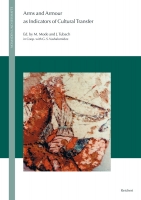Search
Edited by Jürgen Tubach and Markus Mode in Cooperation with Guliko Sophia Vashalomidze
Arms and Armour as Indicators of Cultural Transfer
The Steppes and the Ancient World from Hellenistic Times to the Early Middle Ages
2006
17.0 x 24.0 cm, 520 p., 219 halftones b/w, 3 tables b/w, hardback
ISBN: 9783895005299
17.0 x 24.0 cm, 520 p., 219 halftones b/w, 3 tables b/w, hardback
88,00 €
ISBN: 9783895005299
Short Description
The contributions in this volume give an impression of contemporary archaeological, art historical, and historical research in military equipment of and under the influence of nomadic peoples in Eurasian history. The studies cover a considerably long time span and a broad territory: from the Iron Age up to the Middle Ages, and from Central Europe to the heartlands of China.One special value of arms and armour as an archaeological and art-historical source is its potential to indicate the sharing of knowledge, of technology, but also of experience in a broader sense among completely different cultures. For this reason, the articles in this volume are well established within the framework of the Collaborative Research Centre „Difference and Integration“.
Description
The contributions in this volume give an impression of contemporary archaeological, art historical, and historical research in military equipment of and under the influence of nomadic peoples in Eurasian history. The studies cover a considerably long time span and a broad territory: from the Iron Age up to the Middle Ages, and from Central Europe to the heartlands of China.Aside from strategical and tactical points of view, reasons for nomadic successes in warfare can obviously be seen in their equipment, the systems of weaponry, armour and accessories. These questions about nomadic military equipment are questions for the archaeologist. Analyzing and reconstructing forms, establishing typological sequences, comparing enhancements with shortcomings of arms and armour, the archaeologist is in the position to supplement facts to written history of campaigns and the reasons for successful or lost wars. But of course, this special field of contemporary archaeology should not be merely defined as a „military archaeology“. Arms and armour have to be explained within their archaeological context; that is, as parts of a complex system of remains from past societies. And seen from this perspective, they also explain, beyond their primary character as military sources, the broader sphere of life of nomadic peoples, their efforts in technology and in art, and key aspects of their spiritual world.
One special value of arms and armour as an archaeological and art-historical source is its potential to indicate the sharing of knowledge, of technology, but also of experience in a broader sense among completely different cultures. For this reason, the articles in this volume are well established within the framework of the Collaborative Research Centre „Difference and Integration“.
Series Description
No english description available. Showing german description:
Hg. im Auftrag des SFB von Jörg Gertel, Stefan Leder,
Jürgen Paul und Bernhard Streck
Nomadische und sesshafte Lebensformen koexistieren in weiten Teilen der Welt, insbesondere im altweltlichen Trockengürtel, seit mehreren tausend Jahren. Die Erforschung ihrer Interaktion soll in der Reihe Nomaden und Sesshafte dokumentiert werden. Erst seit vergleichsweise wenigen Jahren hat die Einsicht an Geltung gewonnen, dass Nomadismus als Teil übergreifender ökologischer, ökonomischer, politischer und kultureller Systeme in den Blick genommen zu werden verdient, weil Formen des Kontakts mit der Welt der Sesshaften historische Zivilisationen über lange Zeiträume mitgeprägt haben und noch heute, unter anderen Bedingungen, Wirkung entfalten. Austausch und Konflikt zwischen Nomaden und Sesshaften, wie auch Prozesse der Anpassung und Abgrenzung haben sich auf unterschiedliche Lebensbereiche ausgewirkt. Ökonomie und Militärwesen, politische und soziale Ordnungen, Sprache und in Kunst, Vorstellungswelten und Identitätskonstruktionen geben dies zu erkennen. Mit der Wahrnehmung der Vielfalt und Wirkmächtigkeit dieser Interaktion ist eine Forschungsperspektive angelegt, welche die Aufgaben des 2001 einrichteten Sonderforschungsbereichs "Differenz und Integration – Wechselwirkung zwischen nomadischen und sesshaften Lebensformen in Zivilisationen der Alten Welt" bestimmt.
Der interdisziplinäre Rahmen des Sonderforschungsbereichs erlaubt die Beteiligung mehrerer Disziplinen, wie Archäologie und Geschichte, Literaturwissenschaft und Ethnologie, Geographie und Agrarökonomie; ihr Zusammenwirken verspricht Erträge, die eine Vielzahl von Perspektiven und Wissensbereichen erschließen.




 Preface
Preface

 Neuerscheinungen 2023/2024
Neuerscheinungen 2023/2024
 Gesamtverzeichnis 2023/2024
Gesamtverzeichnis 2023/2024
 Katalog Oriental Studies & Linguistics
Katalog Oriental Studies & Linguistics
 Mittelalter
Mittelalter
 Deutsche Inschriften
Deutsche Inschriften
 Musiktherapie
Musiktherapie
 Literaturen im Kontext
Literaturen im Kontext